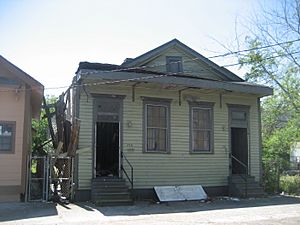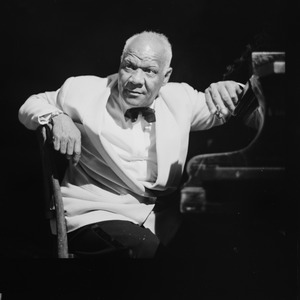Sidney Bechet facts for kids
Quick facts for kids
Sidney Bechet
|
|
|---|---|

Photographic portrait of Bechet in New York, 1947, by William P. Gottlieb
|
|
| Background information | |
| Birth name | Sidney Joseph Bechet |
| Born | May 14, 1897 New Orleans, Louisiana, United States |
| Died | May 14, 1959 (aged 62) Garches, France |
| Genres | Jazz, Dixieland |
| Occupation(s) | Musician, composer |
| Instruments | Clarinet, soprano saxophone |
| Years active | 1908–1957 |
| Associated acts | Louis Armstrong, Tommy Ladnier |
Sidney Joseph Bechet (born May 14, 1897 – died May 14, 1959) was an American jazz musician. He played the saxophone and clarinet and also composed music. Sidney Bechet was one of the very first important solo musicians in jazz. He even recorded music before the famous trumpeter Louis Armstrong.
Contents
Sidney Bechet's Life and Music
Early Life and Musical Beginnings
Sidney Bechet was born in New Orleans, Louisiana in 1897. His family was a middle-class Creole family. His older brother, Leonard, was a dentist who also played the trombone and led a band.
Sidney learned to play many musical instruments around his house. He mostly taught himself. He decided to focus on the clarinet, which he played a lot until about 1919. When he was only six years old, he played with his brother's band at a family party. Everyone loved his talent! Later, he learned from famous musicians like Lorenzo Tio and George Baquet.
Becoming a Jazz Star
Bechet played in many bands in New Orleans. He used the popular jazz style of the time, which included improvising melodies. He performed in parades with Freddie Keppard's band and in the Olympia Orchestra. From 1911 to 1912, he played with Bunk Johnson in the Eagle Band. He also played with King Oliver from 1913 to 1914.
From 1914 to 1917, he traveled and toured. He went as far north as Chicago and often played with Freddie Keppard. In 1919, he moved to New York City and joined Will Marion Cook's Syncopated Orchestra. Soon after, the orchestra traveled to Europe. They performed in London and were very popular. Bechet was especially liked by the audiences.
While in London, Sidney discovered the straight soprano saxophone. He developed a unique playing style on it. His saxophone sound was very emotional and powerful. He often used a wide vibrato, which made his music stand out.
First Recordings and European Adventures
Sidney Bechet started recording music on July 30, 1923. He recorded with Clarence Williams, a pianist and songwriter. They recorded songs like "Wild Cat Blues" and "Kansas City Man Blues." "Wild Cat Blues" was a fast ragtime song, and "Kansas City Man Blues" was a classic 12-bar blues.
In 1919, a Swiss classical music conductor named Ernest Ansermet wrote about Bechet. This was one of the first times a classical musician praised a jazz artist. Ansermet even compared Bechet's music to that of Bach.
On September 15, 1925, Bechet traveled to Europe again. He was part of the Revue Nègre with Josephine Baker. They performed in Paris and toured across Europe, even going to Russia. In 1928, he led his own small band in Paris.
He faced some challenges in Paris that led to him leaving the city. After this, he returned to New York. He joined Noble Sissle's orchestra and toured in Germany and Russia.
Later Career and Innovations
In 1932, Bechet came back to New York City. He led a band with Tommy Ladnier that played at the Savoy Ballroom. He also played with Lorenzo Tio and met trumpeter Roy Eldridge.
In 1938, a song called "Hold Tight, Hold Tight (Want Some Seafood Mama)" became popular. Bechet's guitarist, Leonard Ware, helped write it.
In 1939, Bechet and pianist Willie "The Lion" Smith recorded songs that mixed jazz with Latin American music. They adapted traditional songs from places like Haiti. On July 28, 1940, Bechet appeared on a radio show called The Chamber Music Society of Lower Basin Street. He played two of his famous songs, "Shake It and Break It" and "St. Louis Blues."
Bechet also experimented with recording. On April 18, 1941, he recorded "The Sheik of Araby" by himself. He played six different instruments on the recording: clarinet, soprano saxophone, tenor saxophone, piano, bass, and drums. This was an early example of overdubbing, where a musician records different parts separately and layers them together.
He once described how he recorded it: "I started by playing The Sheik on piano, and played the drums while listening to the piano. I meant to play all the rhythm instruments, but got all mixed up and grabbed my soprano, then the bass, then the tenor saxophone, and finally finished up with the clarinet."
In the 1940s, Bechet played in several bands. However, he still struggled financially for a while. By the end of the 1940s, he felt that the jazz scene in the United States wasn't offering him much anymore.
Moving to France and Final Years
In 1950, Sidney Bechet moved to France. He had performed there as a soloist, and his popularity grew a lot. He found many well-paying jobs in France. In 1951, he married Elisabeth Ziegler in Antibes.
In 1953, he signed a recording contract that lasted for the rest of his life. He recorded many hit songs, including "Les Oignons," "Promenade aux Champs-Elysees," and the international hit "Petite Fleur." He also wrote a classical ballet score called La Nuit est une sorcière (which means "The Night Is a Witch"). Some people in France even called him le dieu, meaning "the god," because of his amazing talent.
Before he passed away, Bechet told his life story for his autobiography, Treat It Gentle. Sidney Bechet died in Garches, France, on May 14, 1959, which was his 62nd birthday. He is buried in a local cemetery.
Bechet also acted as a jazz musician in three films: Série noire, L'inspecteur connaît la musique, and Quelle équipe!.
His playing style was very strong and full of emotion, with a wide vibrato. He was also known for being great at playing many instruments and for his amazing improvisation skills. Bechet liked his sound to be the most important part of a performance.
On June 25, 2019, The New York Times Magazine mentioned Sidney Bechet. They listed him among many artists whose music was reportedly destroyed in the 2008 Universal Studios fire.
Personal Life
Sidney Bechet was Catholic.
Awards
- DownBeat magazine Hall of Fame, 1968
Discography
Singles
- "Texas Moaner Blues", with Louis Armstrong, 1924
- "Cake Walkin' Babies from Home", with Red Onion Jazz Babies, 1925
- "Got the Bench, Got the Park (But I Haven't Got You)", 1930
- "Blues in Thirds", 1940
- "Dear Old Southland", 1940
- "Egyptian Fantasy", 1941
- "Muskrat Ramble", 1944
- "Blue Horizon", 1944
- "Petite Fleur", 1959
Images for kids
See also
 In Spanish: Sidney Bechet para niños
In Spanish: Sidney Bechet para niños









